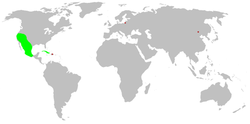Plectreuridae
| Plectreurid spiders Temporal range: Middle Jurassic - Holocene,
| |
|---|---|

| |
| Male plectreurid | |
| Scientific classification | |
| Domain: | Eukaryota |
| Kingdom: | Animalia |
| Phylum: | Arthropoda |
| Subphylum: | Chelicerata |
| Class: | Arachnida |
| Order: | Araneae |
| Infraorder: | Araneomorphae |
| Family: | Plectreuridae Simon, 1893 |
| Genera | |
| Diversity | |
| 4 genera, 33 species | |

| |
Plectreuridae or plectreurid spiders are a small spider family confined to the Southwestern United States, Mexico, and the Caribbean.[1] Only two living genera are known—the nominate genus Plectreurys and Kibramoa. In the past, the family was more widespread, with the Jurassic genus Eoplectreurys known from China, the Eocene Palaeoplectreurys baltica from Baltic amber and the Miocene Plectreurys pittfieldi from Dominican amber.[2]
These ecribellate, haplogyne spiders build haphazard webs under rocks and dead cacti. Adult males can be found wandering at night.[1] Relatively little is known of their biology. Unlike the sicariids, scytodids, and diguetids, to which they are most closely related, they have eight eyes. In appearance females of Plectreurys resemble those of the larger species of the cribellate Filistatidae. They differ in their eye arrangement and in having the femurs on the first pair of legs bowed.
Species
- †Eoplectreurys Selden & Huang, 2010
- †Eoplectreurys gertschi Selden & Huang, 2010 (Middle Jurassic, China)
- Kibramoa Chamberlin, 1924
- Kibramoa guapa Gertsch, 1958 (USA, Mexico)
- Kibramoa hermani Chamberlin & Ivie, 1935 (USA)
- Kibramoa isolata Gertsch, 1958 (Mexico)
- Kibramoa madrona Gertsch, 1958 (USA)
- Kibramoa paiuta Gertsch, 1958 (USA)
- Kibramoa suprenans (Chamberlin, 1919) (USA)
- Kibramoa suprenans pima Gertsch, 1958 (USA)
- Kibramoa yuma Gertsch, 1958 (USA)
- †Palaeoplectreurys Wunderlich, 2004 (tentatively placed in Plectreuridae)
- †Palaeoplectreurys baltica Wunderlich, 2004 (Late Eocene, Baltic Amber)
- Plectreurys Simon, 1893
- Plectreurys angela Gertsch, 1958 (USA)
- Plectreurys ardea Gertsch, 1958 (Mexico)
- Plectreurys arida Gertsch, 1958 (Mexico)
- Plectreurys bicolor Banks, 1898 (Mexico)
- Plectreurys castanea Simon, 1893 (USA)
- Plectreurys ceralbona Chamberlin, 1924 (Mexico)
- Plectreurys conifera Gertsch, 1958 (USA)
- Plectreurys deserta Gertsch, 1958 (USA)
- Plectreurys globosa Franganillo, 1931 (Cuba)
- Plectreurys hatibonico Alayón, 2003 (Cuba)
- Plectreurys janzen Alayón & Víquez, 2011, (Guatemala to Costa Rica)
- Plectreurys misteca Gertsch, 1958 (Mexico)
- Plectreurys mojavea Gertsch, 1958 (USA)
- Plectreurys monterea Gertsch, 1958 (USA)
- Plectreurys nahuana Gertsch, 1958 (Mexico)
- Plectreurys oasa Gertsch, 1958 (USA)
- Plectreurys paisana Gertsch, 1958 (Mexico)
- †Plectreurys pittfieldi Penney 2009 (Miocene, Dominican Amber)
- Plectreurys schicki Gertsch, 1958 (USA)
- Plectreurys tecate Gertsch, 1958 (Mexico)
- Plectreurys tristis Simon, 1893 (USA, Mexico)[3]
- Plectreurys valens Chamberlin, 1924 (Mexico)
- Plectreurys vaquera Gertsch, 1958 (Mexico)
- Plectreurys zacateca Gertsch, 1958 (Mexico)
References
- ^ a b Ubick, D. (2005). Plectreuridae. p. 201 in D. Ubick, P. Paquin, P.E. Cushing, and V. Roth (eds.). Spiders of North America: an identification manual. American Arachnological Society, Keene (New Hampshire).
- ^ Selden, P.A.; Huang, D. (2010). "The oldest haplogyne spider (Araneae: Plectreuridae), from the Middle Jurassic of China". Naturwissenschaften. 97 (5): 449–59. doi:10.1007/s00114-010-0649-z. PMID 20140419.
- ^ T. L. Carpenter, B. J. Bernacky, and E. E. Stabell: "Human Envenomization by Plectreurys tristis Simon (Araneae: Plectreuridae): A Case Report" in Journal of Medical Entomology, Vol. 28 (1991), No. 3, pp. 477-478.
